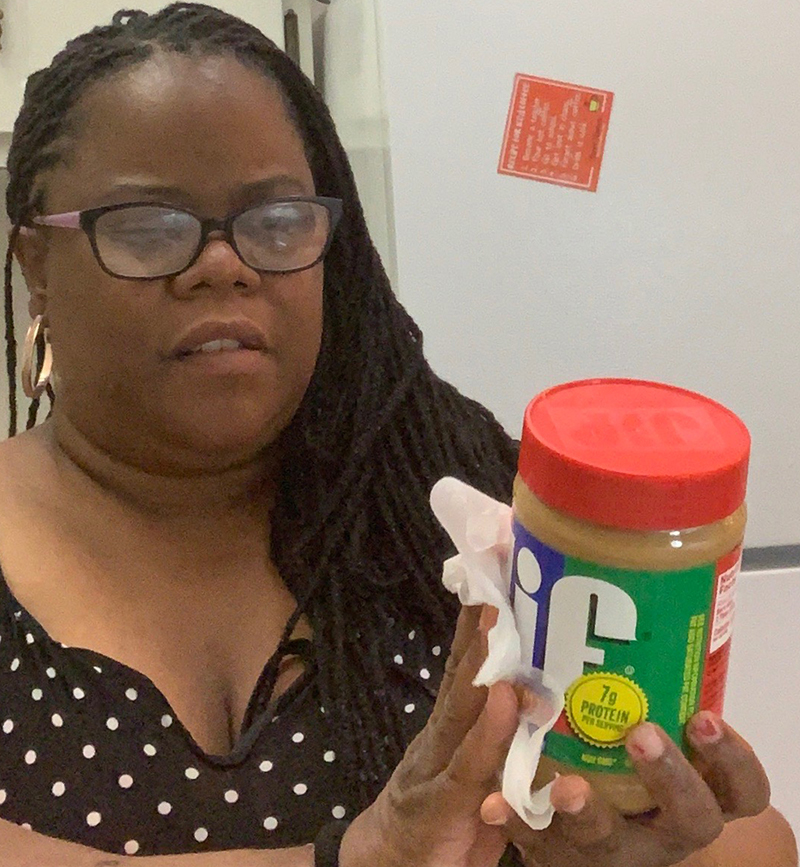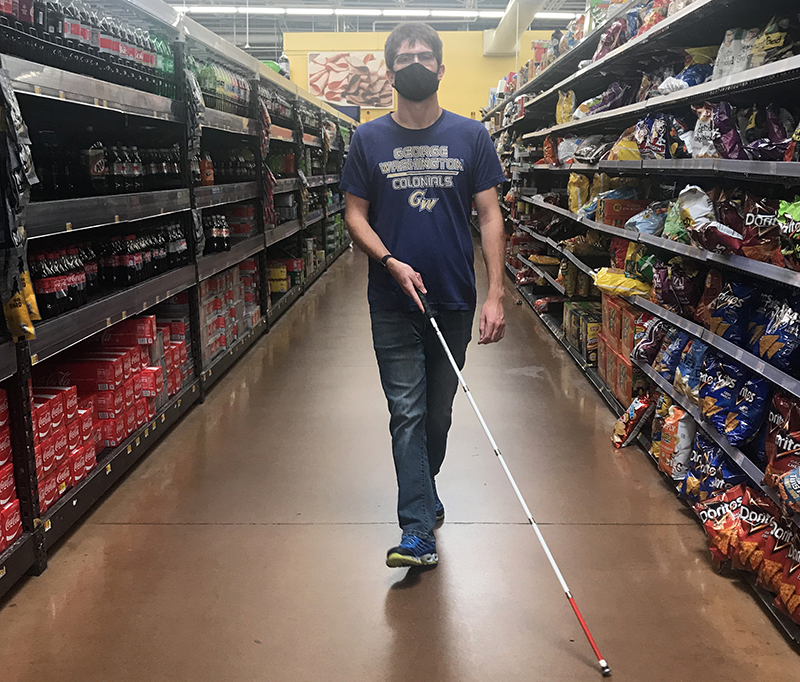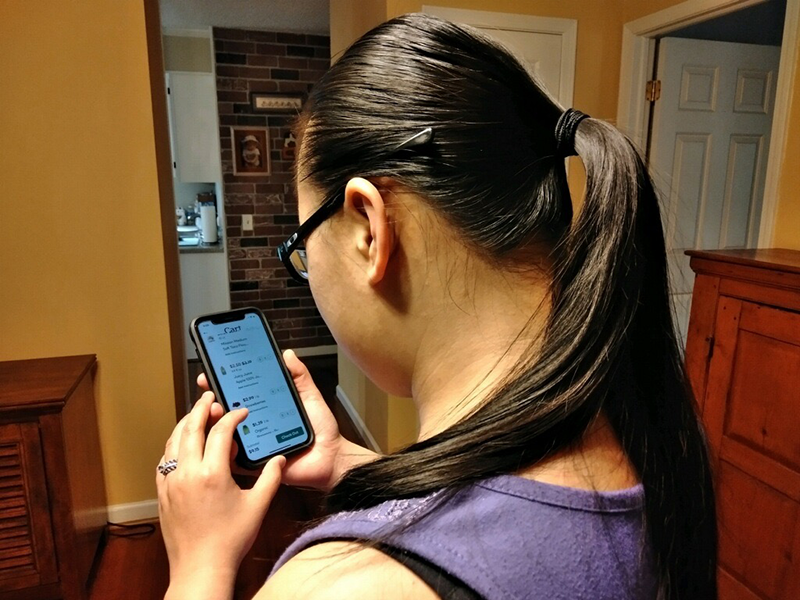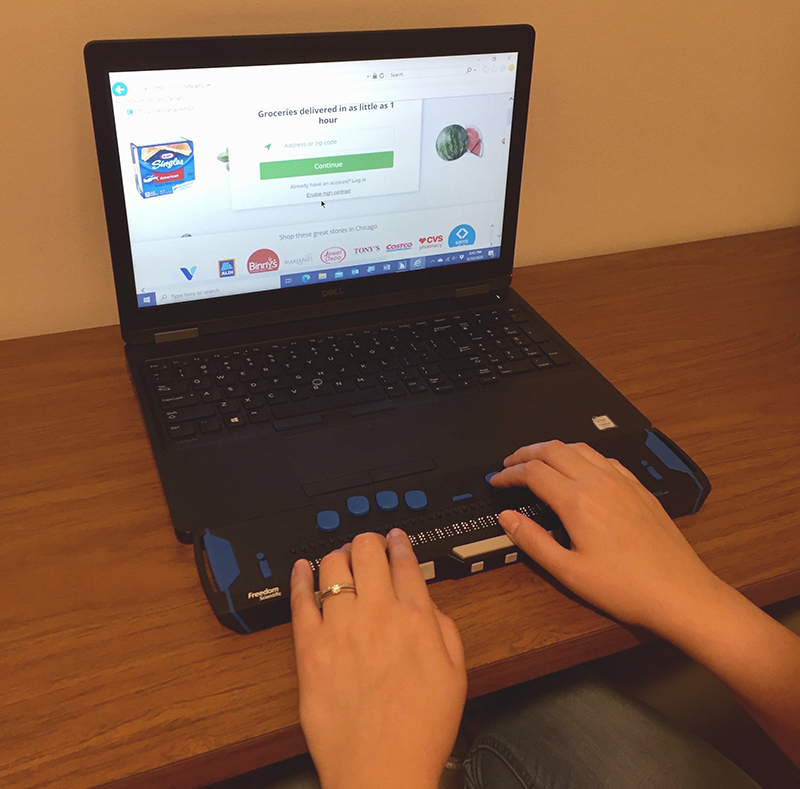My fear is mostly that there will not be any food in the stores. Because of my disability and having to use services, I won't have access to just pop by the store and grab some toilet paper or apples or whatever. I can't do that anymore, so when services like Instacart, Shipt, and even Amazon Prime are booked solid for over a week, that can make you very terrified when you can't even get those services [to deliver].
—Female, aged 25 to 34 years, who did not provide any other demographic information
At the beginning of the COVID-19 pandemic, Americans found themselves having to adjust the ways in which they obtained food, meals, and supplies. The presence of a visual impairment and, in some cases, additional disabilities presented study participants with challenges that for some produced a lot of anxiety. Finding solutions to their challenges necessitated a lot of energy on the part of some participants, whereas others felt their options were limited or nonexistent. Some participants had family, friends, volunteers, or hired assistants who did the shopping, meal preparation, and/or pick-ups for them.
Participants were asked to select all the ways they did their grocery shopping prior to the COVID-19 pandemic. The top three ways participants chose were shopping with a family member or friend (n=1,228), ordering online through companies that deliver, such as Amazon (n=942), and using local online delivery services such as Instacart or those offered from grocery stores (n=750).
Of the 1,921 participants, 931 (51%) had concerns about access to food, meals, and supplies due to COVID-19 and answered questions about this topic, 131 (8%) had concerns about this topic but did not choose to answer questions, and 731 (41%) did not have concerns about access to food, meals, and supplies.
Participants provided their level of agreement to eight concern statements. 14
- I am concerned because when I have tried to use an online shopping service, no delivery slots are available and/or the items I want are out of stock. (n=802, M=4.34, SD=.926)
- I am concerned that because of my visual impairment that I will have difficulty with the application process for SNAP (food stamps). (n=336, M=3.34, SD=1.31)
- I am concerned that because of losing my job or having my hours reduced, I will not be able to afford the food and necessary supplies I need. (n=296, M=3.27, SD =1. 27 )
- I am concerned because my child's school has set up a location for me to come to pick up free meals, but I lack transportation to go to the location. (n=126, M=3.10, SD=1.37)
- I am concerned because the person who assisted me with meal preparation prior to the COVID-19 pandemic is no longer able to assist me. (n=237, M= 2.94, SD =1.3 0)
- I am concerned because prior to the COVID-19 pandemic I, or a member(s) of my family, received food assistance (e.g., Meals-on-Wheels, free school lunches) that is no longer available or has been reduced. (n=255, M=2.84, SD=1.36)
- I am concerned that I do not have enough basic skills to do my own meal preparation and/or housekeeping if I am quarantined for several weeks. (n= 642, M=2.31, SD =1.37)
- I am concerned that I am not able to use online shopping services that deliver because I do not have the technology and/or skills to use the services. (n=736, M=2.19, SD=1.31)
Ordering Through an App or Website
Participants were asked to rate their level of agreement with the statement: "I am concerned because when I have tried to use an online shopping service, no delivery slots are available and/or the items I want are out of stock." Of the participants who rated this statement more females (59%) than males (25%) expressed they agreed or strongly agreed. Participants with a congenital vision loss (54%) had greater concern than those with a childhood vision loss (12%) or vision loss during adulthood (18%). This statement was of higher concern to those who were blind (58%) compared with those with low vision (27%). There was a higher level of concern for participants who did not have an additional disability (48%) compared with those who did have an additional disability (36%).
Many participants shared their experiences related to ordering groceries and/or supplies online whether through an app or website. Prior to the COVID-19 pandemic, a few participants had not used apps or websites to place online orders or set up deliveries.
I did not previously use apps for grocery service delivery, so I had to learn quickly with support from a sighted friend. I now use Instacart regularly on my iPhone with VoiceOver successfully.
—Congenitally VI White male, aged 25 to 34 years, with additional disabilities
Some participants expressed frustration with lack of accessibility of the apps and websites used to place orders. Many participants found it challenging to get a delivery slot through companies including national online companies such as Amazon or Shipt, national retailers such as Walmart and Kroger, or local companies such as the neighborhood pharmacy.
I mainly have been using Peapod because I can get much lower prices than in [major city] stores. I do not know if I have missed an occasional available [delivery time] slot. ... There is no way to find out quickly, but I have looked through three weeks of days and not found anything.
—Childhood-onset VI nonbinary, aged 55 to 64 years, with additional disabilities
There were some participants who shared that they were on a fixed income and/or used government assistance, such as SNAP or the Special Supplemental Nutrition Program for Women, Infants, and Children (WIC). Most online delivery services will not allow customers to make purchases with these funds. One participant spoke about the challenges faced when trying to gather and upload all the information necessary to apply for SNAP funds and how the website was not accessible.
I have a lot of food stamps that I can't use because there is no way to use them with any delivery service. I would like fresh food and any disinfectant supplies, but I can't get these things.
—Congenitally VI White, other gender identity, aged 25 to 34 years, with additional disabilities
Participants were asked to rate their level of agreement with the statement: "I am concerned that because of my visual impairment that I will have difficulty with the application process for SNAP (food stamps)." Of the participants who rated this statement more females (29%) than males (20%) expressed they agreed or strongly agreed, and those 35–54 years had the highest concern (20%) among the three age categories. Participants with a congenital vision loss (27%) had greater concern than those with a childhood vision loss (6%) or vision loss during adulthood (16%). This statement was of higher concern to those who were blind (29%) compared with those with low vision (17%). There was a higher level of concern for participants who did not have an additional disability (26%) compared with those who did have an additional disability (22%).
Getting Ordered Items
Without transportation, there were participants who either could not take advantage of curbside pickup or had to arrange for someone to get their groceries or supplies. Stores, restaurants, banks, and other businesses cannot assume that everyone has a vehicle.
Other participants talked about the challenges of receiving deliveries at home. For those who lived in a secured building, there were issues with drivers not being able to get into the building. Some participants with additional disabilities and/or those who were older commented about the physical energy needed to carry in groceries, disinfect them, and put them away.
Shopping in Stores
Though many participants reported they did not go shopping themselves, others shared their experiences when they did shop.
My greatest concern nowadays is having to most likely use assistance in the store. I am low vision, and I am concerned about bringing items too close to my face to read them. Going forward, I will seek assistance and always travel with my white cane.
—Congenitally VI Black or African American female, aged 65 to 74 years, with no additional disabilities
A few participants expressed concern for their physical safety while shopping. There were a few participants concerned about their ability to maintain a 6-foot social distance, and that not social distancing would be misinterpreted by others at the store. There was variability in how comfortable participants were in asking for assistance from a store employee.
My concern is that if I am out shopping due to panic buying, I may get injured or pushed aside if someone sees an item they want and wants to get past me. I am often slower than other shoppers. Also, I no longer feel comfortable picking up items to look at them closer to find what I'm looking for, so I am relying more on employee assistance.
—Congenitally VI Black or African American female, aged 35 to 44 years, with no additional disabilities
Food Insecurity
Food insecurity was experienced by some participants and others were concerned that if they or a member of the household were to lose their job, additional challenges would occur with obtaining food. For some participants on limited incomes, the rise in food prices forced them to make hard choices between paying bills and the purchase of food and supplies.
You have to buy a little more than usual, because of the delays. Prices have gone up, and if you live only on Social Security income month to month (like I do), it is very hard. Also, some of the mainland (USA) Internet suppliers, do not ship to Puerto Rico, or the shipments are limited to certain items only.
—Adult-onset VI Hispanic female, aged 75+ years, with additional disabilities
Businesses with Drive-Through Service Only
Due to COVID-19, some stores, restaurants, banks, or other businesses had little to no indoor access. Many participants spoke to the challenge that drive-through-only options placed on them and their independence. In some instances, participants were able to successfully walk up to a drive-through; but in other cases, they were not permitted to access the business without a vehicle.
[L]ots of businesses are drive-through only, which excludes me. I admit I have walked through a drive-through because I had no other choice, but even walk-up windows are closed. I do not want to ask friends to help me, as they are worried about their own health and safety.
—Adult-onset VI White male, aged 35 to 44 years, with no additional disabilities
Relying on Others to Shop for You
As a result of the COVID-19 pandemic, there were participants who were not leaving their home to shop, but were instead having others shop for them. In a few instances the shopper was an individual they hired, but in most cases, the shopper was a family member or friend. Some participants expressed frustration that there were items they could not get, and they felt as though they had lost some independence because they were no longer shopping for themselves.
Food Access and Preparation
Few participants had concerns about their ability to prepare meals for themselves or others in their household. Those who did express a concern tended to be over age 55 years.
Since I have become severely disabled and weaker and out of practice, I am not sure I could actually prepare meals, and have very limited ability to clean. I have limited experience with online shopping and some sites aren't very accessible.
—Congenitally VI white female, aged 55 to 64 years, with additional disabilities
With people experiencing layoffs, furloughs, and other changes in their lives, some participants found themselves in need of food assistance. As was the case with drive-through COVID-19 test sites, curbside pick-up at stores, and drive-throughs at restaurants and banks, accessing programs that provide food and meals was problematic for some participants as these programs were set up for drive-through pickup only.
Because of [the] shortage of food in grocery stores, food is being made available to seniors once a week. However, I cannot get it because they cannot deliver it to me and I have no one to pick it up for me.
—Child-onset VI Black or African American female, aged 55 to 64 years, with no additional disabilities
A few participants were having food delivered to them, which demonstrates how those in a community can work together to meet the needs of citizens who do not drive.
Recommendations
Grocery stores, pharmacies, and other essential retailers have been forced to find ways to protect both their employees and customers during the COVID-19 pandemic. While many of the practices instituted were necessary for disease control, survey participants identified that these changes made accessing food and supplies more difficult. Implementing the recommendations below would facilitate easier access to food and supplies for people who are visually impaired and allow businesses to avoid discriminating against people with vision loss as health and safety policies become part of the "new normal."
- Employees must follow the requirements of the Americans with Disabilities Act (ADA) and make "reasonable modifications" to normal business practices when necessary to accommodate people who have disabilities. As a best practice, businesses should provide disability-specific training to employees to ensure that people with disabilities are served appropriately.
- Store management may want to provide specific hours for those who are seniors and those with disabilities to shop. This can enable employees to provide needed assistance to customers when stores are less crowded.
- Businesses may consider providing visual interpreting services, such as Aira or Be My Eyes, to their customers at no or lower cost. This will allow customers to shop independently with sighted assistance through the service.
- Businesses should provide alternative options to "drive-through only" pick-up so that customers without a vehicle can access pick-up by walking-up.
- Those organizing food banks, school meals, or other supply pick-ups for the community must develop and implement a coordinated plan to ensure that alternative considerations are made for people who cannot drive-through.
- Transportation providers can assist those who cannot drive-through or do curbside pick-up by providing delivery to individuals' homes as long as expanding delivery does not reduce the available transportation options.
- Home health companies, consumer organizations, policymakers, and others must work together so those who need in-home support for independent living tasks (e.g., food preparation, someone to shop with them) have access to a trained worker who will follow safety protocols and wear appropriate personal protective equipment.
- Online purchasing with SNAP benefits should be extended to every U.S. state and territory, and eligible retailers should be expanded. Policies that expand access to SNAP, WIC, and other nutritional benefits should be made permanent to provide these critical benefits beyond the pandemic as well.15
- Delivery service personnel must notify customers when they have arrived and are making a delivery. Placing items on a porch, for example, without notifying the customer leads to goods not being found or being stolen.
- Apps such as Instacart, Amazon, and Peapod need to be clearly laid out for those using screen reader technology. Developers of apps should consider accessibility from the beginning. For example, they can provide the option to list items in a cart in table format, have a search feature to find the next available slot, and ensure the layout of components is logical. Developing apps that are high contrast, have clear fonts, and no text over images improves usability for anyone who is visually accessing the app.
- Companies that provide delivery should consider adding features to their apps and websites that make them more usable for those with vision loss. Helpful features may include notification that the delivery will soon be arriving or has been completed, and the location of the delivered items.
I can't say enough that there needs to be some sort of service for anyone who has proof of disability in national or local emergency situations to get access to groceries and medical needs. And public transit should be nationally mandated as ESSENTIAL!
—Congenitally VI White female, aged 25–34 years, with additional disabilities
14. The mean (M) is derived by averaging the participants' ratings, strongly disagree (1) to strongly agree (5). The larger the standard deviation (SD) the greater the spread from the mean of the participants' ratings.



